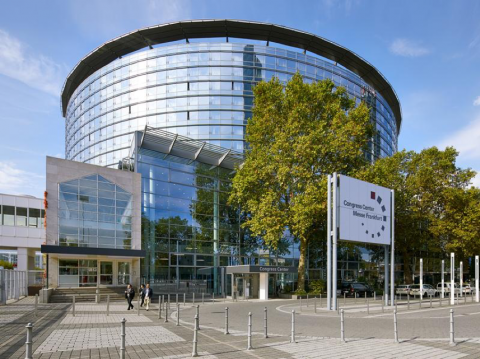The annual EBMT conference was held in Frankfurt this year, and brought together the world’s leading stem cell transplantation clinicians and scientists to share their latest findings.
Members of our Patient Services team attended the conference, alongside our clinical nurse specialists and our recently appointed clinical psychologists. These are their highlights.
All aspects of stem cell transplantation were covered at the conference; from exciting new treatments currently being tested in clinical trials, to improving the management of graft versus host disease (GvHD). Specialist nursing and psychology talks focused on the physical and mental challenges patients face during recovery. And a new series of talks on patient advocacy also looked at the importance of representing the opinion of the patient in all aspects of their care.
CAR-T cells
One of the most striking themes of this year’s conference was the amount of research into developing new CAR-T cells. This treatment involves collecting a patient’s own immune T cells, modifying them to target cancer cells more efficiently, and then injecting them back into the patient. You may have already heard of Kymriah, the first CAR-T cell treatment to be approved for leukaemia, which has featured in one of our blogs.
There are currently more than 300 clinical trials underway worldwide testing new CAR-T cell therapies and results from some of the most promising ones were presented at the conference. This included a CAR-T that could target cancer cells in two different ways, which means it’s much harder for the cancer to remain undetected.
One side effect of CAR-T treatment is known as cytokine release syndrome (CRS), whose symptoms include fever, low blood pressure and has been fatal in a few very extreme cases. To prevent this occurring, CAR-T cell treatments are now being designed to have their own molecular on/off switches. This will allow doctors to have more control over the CAR-T cells by giving a second drug that stops the CAR-T cells working. This type of CAR-T cell has not been tested in patients yet, but lab-based research suggests it could be successful in the future.
Graft vs host disease (GvHD)
When a patient develops GvHD they’re often treated with a combination of steroids and drugs that supress their immune system. For many patients this is successful, but some patients develop steroid resistant GvHD, which is more difficult to treat. While many treatment options are available to these patients, they have had varied success, leading to debate in the medical community about which one is most suitable.
Research from both academic and pharmaceutical companies was presented on the latest GvHD treatments. They included conventional drugs, extracorporeal photopheresis (ECP) and even mesenchymal stromal cells – a type of blood cell that helps to control inflammation in the body.
Even though these treatments were effective for some patients, it highlighted the need to be able to predict how patients will react to a treatment before it’s given. One possible way to do this is to use biomarkers, whose presence (or absence) in a patient’s blood sample indicates how successful a treatment might be. Early clinical studies, which select patients based on the biomarkers they express, are now underway and could have a big impact on the treatment of GvHD in the coming years.
Psychological support
Healthcare professionals are becoming increasingly aware of the psychological impact of stem cell transplants on patients and their families. There is now a whole day at the meeting dedicated to psychological support.
The talks focused on how mental health concerns are identified in patients and how they’re treated. There was also a lot of discussion about how appropriate patient questionnaires and other assessment tools can be, and when it’s the correct time to use them. There is variation in these approaches across the UK and Europe, but everyone agreed they should be measured in a more systematic way. More research is currently underway to work out the best way to do this.

Transitioning care from adolescent to adulthood
As part of the nurse’s day presentations, the challenges for adolescents that transition to adult care were discussed. This included dependency of parents, effects on body image, self-esteem and disrupted education and employment opportunities.
A system used in French hospitals highlighted that transitions need to be a collaborative approach between paediatric and adult teams. Support and education for adult services in understanding the unique challenges of adolescents and ensuring continuation of the support received in the paediatric service is essential. Helping adolescent patients to adapt to the adult service and encouraging independent self-care is also needed.
Patient information
The EBMT conference also invites health care professionals to submit their research findings in the form a poster that can be displayed during the event. They can be on any area of interest and this year showcased projects that looked at how health information is communicated to patients and families. This included a French cookbook of recipes for patients in early recovery and an interactive comic for teenagers that explains how immunotherapy works.
Various nursing posters also looked at communicating complex medical treatments with patients as well as accommodating a patient’s non-medical needs, such as their religion, during their hospital stay.
Over the coming months we are likely to see the full results of some of these exciting and promising clinical trials being published in medical journals. This will hopefully lead to new treatments being approved for clinical use.
Next year’s EBMT conference will take place in Madrid from 22nd – 25th of March.
